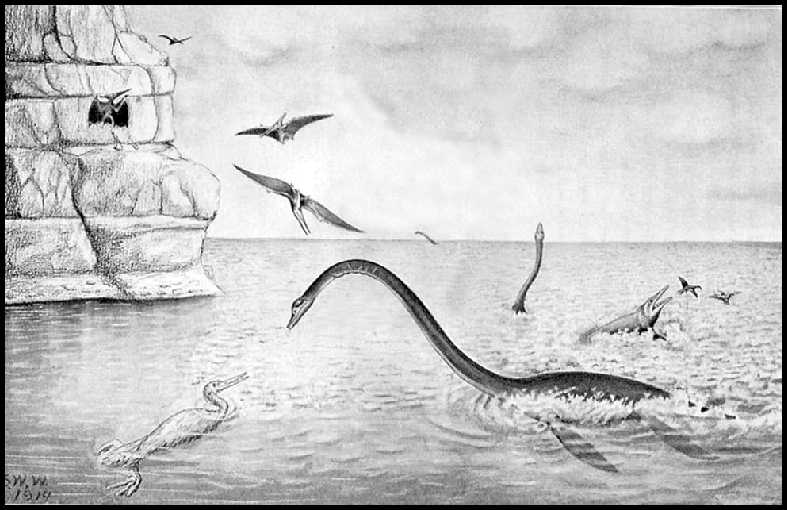| Cope.]
168
[Oct. 20 ............
Note of some Cretaceous Vertebrata in the State Agricultural
College of
Kansas, U. S. A.
By Edward D. Cope.
MANHATTAN, KANSAS, 1871
MY DEAR PROF.
LESLEY:
A visit to the State Agricultural College of Kansas at
Manhattan, has enabled me to examine the cretaceous vertebrata in its collection.
Professor B. F. Mudge, already well known by his interesting discoveries among the Pythonomorph
reptiles and Saurodont Fishes, has added to his collections by an excursion in
l871
169
[Cope.
the neighborhood of Fort Wallace, during the present summer. By his permission
I have made an examination of these fossils, and find them to be of much interest. They
consist of seven species of Pythonomorpha, and three of Saurodontidæ. The following are
approximate or exact determinations of them.
PYTHONOMORPHA.
MOSASAURUS quite near to M.
depressus, Cope, from New Jersey.
LIODON DYSPELOR,
Cope, probably. The first time that this gigantic reptile has been discovered in Kansas.
LIODON [Liodon crassartus]; a large species near to L. proriger,
Cope. It is represented by dorsal, lumbar, and caudal vertebræ, by ribs, and by bones of
the extremities. The humerus is a remarkable bone having the outline of that of Clidastes
propython, Cope, but is very much stouter, the antero-posterior dimensions of the
proximal extremity being greatly enlarged, The long diameters of the two extremities are
in fact nearly at right angles, instead of in the same plane, and the outline of the
proximal is subtriangular, one of the angles being prolonged into a strong deltoid crest
on the outer face of the bone, which extends half its length. The inner or posterior
distal angle is much produced, while the distal extremity is a flat slightly curved
diamond-shaped surface. The radius is as broad as long and three quarters of a disc. The
phalanges are stout, thick and depressed, thus differing much from those of Liodon
ictericus. A bone which I cannot assign to any other position than that of femur* has
a peculiar form. It is a stout bone but more slender than the humerus, The shaft is
contracted and subtrilateral in section. The extremities are flattened, expanded in
directions transverse to each other, the proximal having, however, a lesser expansion, in
the plane of the distal end. The former has, therefore, the form of an equilateral
spherical triangle, the apex enclosing a lateral fossa and representing probably the great
trochanter. The distal extremity is a transverse and convex oval.
M.
Length humerus.......................................................
0.10
Proximal diameter do..............................................
.095
Length femur ..........................................................
.08
Proximal diameter do .............................................
.065
Median "
......................................................
.035
Length centrum dorsal vertebra without ball .......
.061
Transverse diameter cup ......................................
.06
Vertical "
.......................................................
.053
LIODON LATISPINUS,
Cope, sp. nov.
This is a large species, nearly equaling the L.
mitchillii in its dimensions, that is forty or fifty feet in length. The remains
representing it consist of seven cervical and dorsal vertebræ, five of them being
continuous and enclosed in a clay concretion.
Prof. O. C. Marsh has discovered the posterior limbs in this
genus and Clidastes but has as yet published no description of them. See Silllm.
Journ. 1871, p. 418.
A. P. S. -VOL. XII - V
Cope.]
170
[Oct. 20
These display the elongate character seen in L. laevis, etc., but the
articular surfaces are transversely oval, thus resembling the L. ictericus. They
are less depressed than in L. perlatus and L. dyspelor. The cup and ball of
the penultimate cervical rise a little more transverse than those of the fourth dorsal.
The last cervical is strongly keeled on the middle line below, and with a short obtuse
hypopophysis marking the beginning of the posterior third of the length; the median line
of the first dorsal has an obtuse ridge. There is no keel on the fourth dorsal. The
diapophyses on the last two cervical and three first dorsal vertebræ have great vertical
extent; the articular surface for the rib is not bent at right angles on the last
cervical. Neural arches and spines are well preserved in most of the specimens. There is
no trace of zygantrum. The neural spines are flat, and have considerable antero-posterior
extent on cervical as well as dorsal vertebræ, and are truncate above. The first dorsal
has a long strong rib.
M.
Transverse diameter cup penultimate cervical vertebra
.051
Vertical diameter of same
.041
Length centrum fourth dorsal, without ball
.072
Vertical diameter ball
.0455
Transverse do
.0555
Elevation front margin neural spine penultimate cervical
.088
Antero-posterior diameter
do
do
do
.05
There are smooth bands around the balls and the
surfaces of the centra are striate to these.
The depressed cups of the cervicals and anterior
dorsals distinguish this species from the L. validus, L. proriger and L. mudgii.
The same elements are much larger and more elongate than in L. ictericus.
LIODON, sp. near ictericus,
Cope.
Represented in Prof. Mudge's collection by portions of
cranium including jaws and quadrate bones, etc., with cervical and dorsal vertebræ.
CLIDASTES VYMANII,
Marsh, probably.
CLIDASTES CINERIARUM, Cope.
Dorsal and cervical vertebræ.
SAURODONTIDÆ.
ICTHYODECTES, nr. ctenodon,
Cope.
ANOGMIUS CONTRACTUS,
gen. et sp. nov. ? Saurodontidarum.
Represented by a large series of vertebræ and
portions of fins of an individual of perhaps four feet in length. The characters of the
vertebræ are those of Ichthyodectes in part, i. e. they lack the lateral grooves,
but they resemble those of Saurocephalus in having the basal elements of the neural
and haemal elements inserted by gomphosis and not coössified with the centrum.
Specifically, the centra are relatively longer than in I. ctenodon, and more as in
the shorter forms of Saurocephalus, as S. prognathus, which species the
present one approaches in size.
SAUROCEPHALUS, nr. prognathus,
Cope. |

